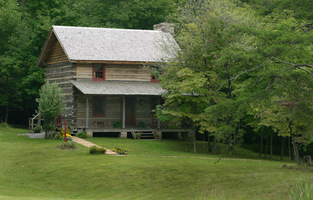 | Back to e-WV
| Back to e-WV
 The West Virginia Encyclopedia
The West Virginia Encyclopedia
 | Back to e-WV
| Back to e-WV
 The West Virginia Encyclopedia
The West Virginia Encyclopedia

The prevailing theory about the origins of log construction throughout the southern Appalachian region, and West Virginia in particular, is that this building method arrived with early settlers from Pennsylvania. The two dominant ethnic groups to settle Western Virginia, the Scotch-Irish and the Pennsylvania Germans, were influenced by Finnish and Swedish log building and construction techniques in Pennsylvania. The Finns and Swedes were well situated there by the time the Scotch-Irish and Germans arrived in the New World beginning in the late 17th century.
In part through necessity, hewn logs were the material of choice for home and farmstead buildings of the pioneers. However, after sawn boards became widely available by the mid-19th century, many in the Mountain State continued the log form of construction. Logs were generally free to landowners, and for reasons of both economy and tradition, numerous log buildings were constructed well into the 20th century. Older log buildings today are most prevalent in the eastern counties where the ‘‘rain shadow’’ of the state’s highest ridges means limited rainfall,helping to preserve the structures.
The most widely found log-notching technique in West Virginia is the half dovetail. The V notch is also common, while full dovetail and square notching are rare. Some more crudely constructed outbuildings and barns feature round logs (instead of being hewn flat on the sides) with rough saddle-notched joinery. Today many older houses are sealed both inside and out with boards, hiding the carefully hewn logs that form the strength of the construction. Likewise, ‘‘puncheon’’ floors, formed through laying hewn logs together to form a flat surfaced floor, are rarely seen as they have been covered over with smoother boards.
Given that trees used for logs are by nature limited in length, types of building construction were therefore similarly limited. Early buildings were raised by manpower, thus providing another limiting factor to their size. Larger buildings could be constructed through the use of the log ‘‘crib,’’ a square section of logs ranging from 12 to 30 feet on a side. Two cribs, placed from eight to 20 feet apart, are joined by one roof in both house and barn design and became a distinct architectural form, the dog trot or breezeway style. This traditional style, especially in barns, remained a popular style that is widely duplicated in more recent lumber framed buildings, even though the limiting factor of log length no longer applies.
Upon close inspection, most logs in older buildings may be seen to consist of the more durable species of Appalachian hardwoods. In the limited high altitude growing area of the eastern mountains, red spruce was the species of choice. However one can also find chestnut, oak, and yellow poplar (tulip poplar in a large, mature stage) throughout the state, and many older houses and barns contain more than one variety of tree. Pine is often used today in the log ‘‘kit homes,’’ or mass produced log houses that are delivered to home sites and assembled.
Written by Gerald Milnes
Montell, Lynwood W. & Michael L. Morse. Kentucky Folk Architecture. Lexington: University Press of Kentucky, 1976.
McRaven, Charles. Building the Hewn Log House. New York: Thomas Y. Crowell, 1978.
Sloane, Eric. A Museum of Early American Tools. New York: Ballantine Books, 1964.
Milnes, Gerald C. The Barns of Pendleton County. Goldenseal, (Spring 1998).